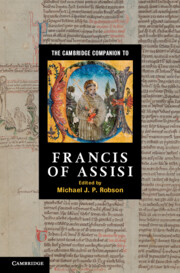Book contents
- Frontmatter
- Introduction
- PART I Francis of Assisi
- 1 Francis and the Franciscan movement (1181/2–1226)
- 2 The writings of Francis
- 3 The Rule and life of the Friars Minor
- 4 Francis and his hagiographical tradition
- 5 Voluntary simplicity: the attitude of Francis towards learning in the early biographies
- 6 Francis and the historiographical tradition in the order
- 7 Francis and Clare and the emergence of the Second Order
- 8 Francis and the encounter with the sultan (1219)
- 9 Francis and creation
- PART II The heritage of Francis of Assisi
- Index
2 - The writings of Francis
from PART I - Francis of Assisi
Published online by Cambridge University Press: 28 November 2011
- Frontmatter
- Introduction
- PART I Francis of Assisi
- 1 Francis and the Franciscan movement (1181/2–1226)
- 2 The writings of Francis
- 3 The Rule and life of the Friars Minor
- 4 Francis and his hagiographical tradition
- 5 Voluntary simplicity: the attitude of Francis towards learning in the early biographies
- 6 Francis and the historiographical tradition in the order
- 7 Francis and Clare and the emergence of the Second Order
- 8 Francis and the encounter with the sultan (1219)
- 9 Francis and creation
- PART II The heritage of Francis of Assisi
- Index
Summary
Francis of Assisi expounded the mysteries of the Gospel in an attractive and persuasive manner. A good description of him was given by Thomas, archdeacon of Split, who was present at a sermon which Francis preached in the piazza at Bologna on 15 August 1222. His clothing and personal appearance were contrasted with the vigour and power of his words, which restored harmony and peace to a troubled and divided city. Dr Rosalind Brooke describes Francis as ‘a subtle, self-conscious, imaginative teacher’ who communicated the Gospel with a telling clarity. Words, symbols and gestures were deftly used to convey the teaching of Jesus Christ. Thomas of Celano remarks that Francis made a tongue of his whole body in the service of Christianity (1 Cel., 97). Francis's collection of letters is minuscule in comparison with the voluminous correspondence of Anselm of Canterbury (c. 1033–1109), Bernard at Clairvaux (1090–1153) and Peter the Venerable (1092–1156). Apart from the Rule, his writings take the form of exhortations to observe the Gospel as fully as possible, while some letters deal with specific matters, such as the implementation of Honorius III's instruction Sane cum olim on 22 November 1219. There are two autographed texts: first, the letter to Brother Leo and secondly, the praises of God and a blessing upon the same friar. Copies of Francis's writings were treasured and distributed with his blessing. They circulated during his lifetime and not long after his death, forming the basis for the early manuscript tradition and the critical edition of his works.
- Type
- Chapter
- Information
- The Cambridge Companion to Francis of Assisi , pp. 34 - 49Publisher: Cambridge University PressPrint publication year: 2011



